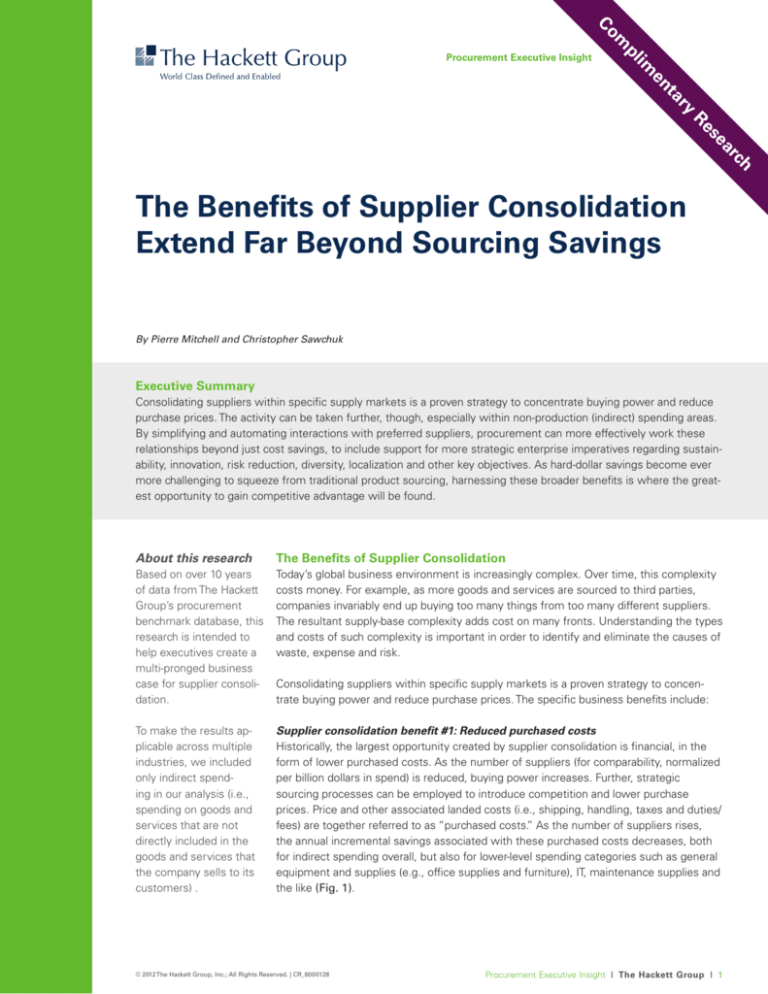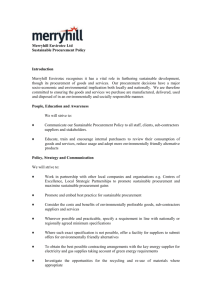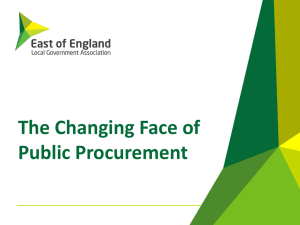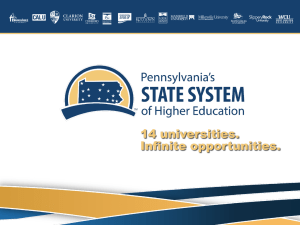
m
Co
pl
im
Procurement Executive Insight
en
ry
ta
ea
s
Re
h
rc
The Benefits of Supplier Consolidation
Extend Far Beyond Sourcing Savings
By Pierre Mitchell and Christopher Sawchuk
Executive Summary
Consolidating suppliers within specific supply markets is a proven strategy to concentrate buying power and reduce
purchase prices. The activity can be taken further, though, especially within non-production (indirect) spending areas.
By simplifying and automating interactions with preferred suppliers, procurement can more effectively work these
relationships beyond just cost savings, to include support for more strategic enterprise imperatives regarding sustainability, innovation, risk reduction, diversity, localization and other key objectives. As hard-dollar savings become ever
more challenging to squeeze from traditional product sourcing, harnessing these broader benefits is where the greatest opportunity to gain competitive advantage will be found.
About this research
The Benefits of Supplier Consolidation
Based on over 10 years
of data from The Hackett
Group’s procurement
benchmark database, this
research is intended to
help executives create a
multi-pronged business
case for supplier consolidation.
Today’s global business environment is increasingly complex. Over time, this complexity
costs money. For example, as more goods and services are sourced to third parties,
companies invariably end up buying too many things from too many different suppliers.
The resultant supply-base complexity adds cost on many fronts. Understanding the types
and costs of such complexity is important in order to identify and eliminate the causes of
waste, expense and risk.
To make the results applicable across multiple
industries, we included
only indirect spending in our analysis (i.e.,
spending on goods and
services that are not
directly included in the
goods and services that
the company sells to its
customers) .
Supplier consolidation benefit #1: Reduced purchased costs
Historically, the largest opportunity created by supplier consolidation is financial, in the
form of lower purchased costs. As the number of suppliers (for comparability, normalized
per Cillion dollars in spend) is reduced, buying power increases. Further, strategic
sourcing processes can be employed to introduce competition and lower purchase
prices. Price and other associated landed costs (i.e., shipping, handling, taxes and duties/
fees) are together referred to as “purchased costs.” As the number of suppliers rises,
the annual incremental savings associated with these purchased costs decreases, both
for indirect spending overall, but also for lower-level spending categories such as general
equipment and supplies (e.g., office supplies and furniture), IT, maintenance supplies and
the like (Fig. 1).
Consolidating suppliers within specific supply markets is a proven strategy to concentrate buying power and reduce purchase prices. The specific business benefits include:
© 2012 The Hackett Group, Inc.; All Rights Reserved. | CR_6000128
Procurement Executive Insight I The Hackett Group I 1
FIG. 1 Supplier consolidation is correlated to reduced purchased costs
Indirect spend
General equipment & supplies
31,994
3.35%
9.18%
49,458
2.43%
2.39%
5.35%
1.81%
4,155
10,384
4,548
Bottom
quartile
Third
quartile
Second
quartile
2.04%
1.83%
Bottom
quartile
Third
quartile
837
2,052
Top
quartile
Second
quartile
PURCHASED COST
REDUCTION AS A PERCENT
OF SPEND
107
Top
quartile
SUPPLIERS PER US$
BILLION OF SPEND
Source: The Hackett Group, 2012
Supplier consolidation benefit #2: Reduced procurement and supplier management costs
While lowered purchase price represents the largest source of hard-dollar savings from
supplier consolidation, reduced process cost (i.e., increased efficiency) may be the
largest opportunity. With fewer suppliers, the number of separate transactions falls,
as does the amount of time it takes to manage those suppliers. It costs roughly $700$1,400 in internal costs (i.e., labor, outsourcing, technology and related overhead) to
source each supplier, set it up in internal systems, transact with it and manage the
relationship on an ongoing basis.1 So, fewer suppliers means lower interaction costs. This
correlation is borne out with data showing that as the normalized number of suppliers
goes down, so does the resultant labor effort in terms of FTEs required and spendnormalized process cost (Fig. 2).
FIG. 2 Supplier consolidation leads to higher procurement process efficiency overall
1.068%
121
0.755%
0.703%
0.637%
74
51
Bottom
quartile
(31,994)
Third
quartile
(10,384)
44
Second
quartile
(4,548)
Top
quartile
(2,052)
Number of indirect suppliers per US$ billion in indirect spend
FULL-TIME EQUIVALENTS (FTE)
PER US$ BILLION IN
INDIRECT SPEND
COST OF PROCUREMENT PROCESSES
AS A PERCENT OF SUPPLIER SPENDING
(INDIRECT)
Source: The Hackett Group, 2012
1
© 2012 The Hackett Group, Inc.; All Rights Reserved. | CR_6000128
It is important to note that eliminating a supplier will not immediately create these process efficiency savings,
but such improvements, over time, will indeed reduce staffing requirements and allow staff to redirect their
attention to more strategic activities.
Procurement Executive Insight I The Hackett Group I 2
Consolidate beyond traditional
spending category silos
At many procurement organizations, category managers who own various spend categories will engage the supplier market within their own spending silos. Yet, there is no
reason why organizations cannot further broaden their “market baskets” to aggregate
demand across the spend categories (Fig. 3). For example:
t A large office supplies vendor might also have a compelling value proposition for IT
equipment, print services/equipment, MRO supplies, etc.
t A building services management provider may also provide compelling MRO management services.
t A group purchasing organization could be used to aggregate demand across multiple
spend categories if the company has little supplier leverage by itself.
t A minority-owned Managed Service Provider (MSP) could be used to aggregate
across multiple services procurement categories and help improve supplier diversity
performance.
t A large outsourcing company could subsume the spending within a category such
as IT, or could also be used for business process outsourcing (BPO) in HR, finance or
other business support service.
The idea is to open up a broader market basket to suppliers and see what the market
will bear, rather than bring preconceptions of what suppliers can or cannot do. Of
course, there is a limit to hard-dollar savings driven by supplier consolidation. As
supplies become more commoditized, there are fewer price differences to be found
among suppliers. At the end of the day, there are only so many dollars to squeeze out
of a ream of paper or an office chair. While organizations need to explore these savings,
they also need to challenge themselves to look for other ways to deliver value and ROI.
FIG. 3 Supplier consolidation can take place beyond low-level commodities and even major spend categories
No aggregation
Category
aggregation
Commodity aggregation
Cross-category
aggregation
Office Equipment
Office Furniture
Office Supplies/
Equipment Category
Management
Example non-production spend commodities
Office Services - Document Management
Office Services - Mailroom
Office Supplies
Facilities: Real Estate and Property Management
Facilities: Janitorial/Custodial
Facilities: Capital Equipment
Facilities: HVAC Equipment/Service
MRO Equipment and Supplies: Cleaning and Safety Supplies
Facilities/MRO/
CapEx Category
Management
MRO Equipment and Supplies: Electronics/Electrical Supplies
MRO Equipment and Supplies: Machinery and Equipment
Aggregate
across
categories to
see what the
market will
bear
IT Hardware: Laptop
IT Hardware: Desktop
IT Hardware: Accessories
IT Hardware: Production Server
IT Hardware: Storage
IT Category
Management
Telecom: Cellular
Telecom: Data
Telecom: Network Equipment
Source: The Hackett Group, 2012
© 2012 The Hackett Group, Inc.; All Rights Reserved. | CR_6000128
Procurement Executive Insight I The Hackett Group I 3
This represents a virtuous cycle in that having a smaller number of suppliers makes it
easier to automate interactions with them, which in turn drives down the process costs
and frees up staff to make further improvements. For example, in terms of efficiency
improvements, the level of purchase automation increases as the number of suppliers
goes down (Fig. 4). We also see that the total steady-state cost for a purchase (which
includes transactional buying, receiving and paying for goods/services) is less than $9
for a top-performing procurement organization2, compared to $25 for the peer group. In
addition, there are similar transactional benefits in terms of reduced cycle times (which
also lead to improved requisitioner satisfaction), error rates, and the extent of supporting
processes required for supplier set-up and ongoing management.
FIG. 4 Fewer suppliers simplifies process automation, in turn reducing P2P costs
Percent of POs electronically disseminated to
suppliers (indirect spend)
Process cost per purchase
(includes cost per PO, receipt and invoice)
$24.88
70%
77%
83%
54%
$8.87
Bottom
quartile
(31,994)
Third
quartile
(10,384)
Second
quartile
(4,548)
Top
quartile
(2,052)
Peer group
World-class
Number of indirect suppliers per US$ billion in indirect spend
Source:
The Hackett
Group, 2012
Supplier
consolidation
benefit #3: Reduced noncompliance – and increased stakeholder satisfaction
In terms of effectiveness-related benefits from supplier consolidation (beyond cost
savings), improved compliance ranks among the largest. It includes:
t Supplier compliance from engaging suppliers that have capable processes/systems
and are comfortable performing transparently against service level agreements (SLAs).
Contract/SLA non-compliance varies greatly, but savings of up to 1-2% of spending
are not uncommon when companies first address this area (e.g., ensuring discount
capture, minimizing duplicate payments). Picking fewer suppliers and managing them
actively and professionally is critical to enabling this area of value.
t Internal compliance to contracts, especially regarding use of corporate negotiated
discounts. Based on Hackett benchmark data, we conservatively estimate the benefit
from reducing missed discounts from contract noncompliance at about 10% of negotiated savings.
t Internal compliance and supplier compliance to regulatory requirements including
fraud reduction, supplier diversity requirements and localization requirements, among
others. With fewer suppliers, it becomes easier to monitor against these ever-increasing
requirements.
Of course, there is a trade-off regarding the last two items above in terms of managing
requisitioners who prefer local suppliers or suppliers that better fit their individual
requirements than the corporate supplier. However, this can be mitigated in various
ways:
2
© 2012 The Hackett Group, Inc.; All Rights Reserved. | CR_6000128
“Top performer” is a designation given to companies that are in the top quartile across a broad set of
purchase-to-pay performance metrics in The Hackett Group’s ongoing benchmark database.
Procurement Executive Insight I The Hackett Group I 4
t Make it extremely easy and intuitive for requisitioners to find what they are looking for
with preferred suppliers. If they have budget and can find what they need within the
corporate catalog, the process should be 100% automated, foolproof and transparent.
t Offer a process to route truly nonstandard requirements to procurement to support
appropriate one-off purchases or to add an exception (upon approval by senior management to accept the trade-off versus the benefits of the existing contract).
t Provide transparency of noncompliance to budget owners. For example, sending a
missed-discounts report to the senior-most executive in charge of a budget is a powerful
tool to change behaviors.
t Integrate all local requirements (and others such as payment term requirements to
support working capital objectives) comprehensively into the sourcing process to help
quantify and address trade-offs and decisions, rather than after the fact.
t Use suppliers themselves as monitoring agents and change agents in the process.
The procurement organization and budget owners might be unaware that the supplier
already has capabilities to meet apparently nonstandard requirements.
This last point is not just a compliance tactic, but also applicable for tapping suppliers’
knowledge of best practices more broadly based on their work with other customers. In
fact, many similar best practices go hand in hand with supplier consolidation. A few of
the best are highlighted in the next section.
Making Supplier Consolidation Happen
The goal of reducing complexity should not just apply to the supply base, but also to the
processes and systems that are used to interact with the supply base. For example:
t Rationalization of the few approved methods for buying and paying for goods and
services. This includes not just three-way matching (which is the most onerous of all
methods), but also use of procurement cards for very low-dollar and/or emergency
purchases, assumed receipts, recurring invoices, evaluated receipts (i.e., no invoice is
issued since the receipt serves as the invoice), etc. These should be designed based
on the requirements of the spend categories that have been determined upstream
during the sourcing process.
t Online catalogs (local or via “punchout” to supplier site), automated requisitioning via
e-procurement systems, procurement card integration (including use of summarized
invoices and integration to T&E systems) and e-invoicing applications are important
technology capabilities which correlate strongly to purchase-to-pay (P2P) performance.
These technologies, combined with those of the suppliers, and with best-practicesbased process design, should allow for a multi-channel approach to support on-premises
purchases with suppliers as well as electronic purchasing over the Internet (including
mobile devices).
© 2012 The Hackett Group, Inc.; All Rights Reserved. | CR_6000128
Procurement Executive Insight I The Hackett Group I 5
FIG. 5. Procurement spend influence helps consolidate suppliers and improve their ongoing
management
Percent of indirect spend influenced or
managed by procurement
86%
71%
76%
Allows application of other
procurement best practices:
60%
Bottom
quartile
(31,994)
3 Simplification and standardization of specifications
3 Improved compliance
(internally and with suppliers)
3 Supplier collaboration to
provide ongoing support for
localization, sustainability,
innovation, etc.
Third
quartile
(10,384)
Second
quartile
(4,548)
Top
quartile
(2,052)
Number of indirect suppliers per US$ billion in indirect spend
Source: The Hackett Group, 2012
These actions not only make end-users happier but allow procurement, finance and other
business staff to spend more time fulfilling higher-level objectives. When procurement
has the opportunity to influence supplier spending earlier in the process, it can apply a
much broader toolkit of practices to help the business get more value from that spend
over the life cycle of the supplier relationship and not just at the time of the deal (Fig. 5).
Supplier relationship management (SRM) has increasingly become top-of-mind for
procurement leaders and business leaders alike. SRM allows deeper collaboration
with the core suppliers that have emerged as preferred partners during the supplier
consolidation process. SRM is a very complex subject3, but it is clear from Hackett
research that supplier consolidation is strongly correlated with SRM performance and
has an even higher ROI than strategic sourcing, especially given the broader focus on
innovation and growth that SRM helps enable.
One of the hallmarks of world-class procurement organizations is their ability to source
suppliers strategically even though the spend itself may not be very strategic. What we
mean is that suppliers that have made it through the consolidation process are managed
in a way that is similar to more strategic suppliers; namely, they are held accountable to a
broader set of performance requirements which are both multi-year and multi-pronged.
Rather than having dedicated category managers and non-core spending areas,
companies can either outsource the procurement of this spend entirely (as done in
only a minority of companies at present), or press the supplier to apply the proven best
practices implemented at its other, more progressive, customers. It should consist of a
multi-phase implementation plan that hits on all the best practices we see empirically
demonstrated at world-class procurement organizations: specification simplification,
consumption management, inventory rationalization, global sourcing and working
capital programs, among others. A case study on the next page details one company’s
experience partnering with a preferred supplier to expand business value delivered.
3
© 2012 The Hackett Group, Inc.; All Rights Reserved. | CR_6000128
SRM is the topic of our newest Book of NumbersTM, produced exclusively for members of our Procurement
Executive Advisory Program. Currently on press, the book will be shipped to clients before year-end.
Procurement Executive Insight I The Hackett Group I 6
Case study: Guild Mortgage
Company
A fast-growing mortgage banking company, Guild Mortgage was trying to instill disciplined growth from a cost standpoint, especially with the expansion of its retail location
footprint. To this end, it worked on standardizing office consumption/configuration not
just for office supplies/equipment spending, but for overall operations including support
for nationally designed, locally executed marketing campaigns.
Strategic sourcing helped support disciplined growth by consolidating the company’s
supply base, which in turn led to office equipment/supplies savings that surpassed the
top-quartile savings figure shown in Fig. 1 on page 2 of this report. These initial harddollar savings were certainly something to be celebrated, but the effort also opened up
over 40 more hours per month for operations management to focus on supporting business growth. This focus naturally extended to preferred suppliers, which Guild Mortgage
actively encouraged to continuously expand the value delivered within existing spend
categories and also reach into adjacent spending areas. Interestingly, the company did
not have a dedicated procurement spend-category manager, but rather, asked its preferred supplier (Staples Advantage) to deliver a multi-year plan based on best practices
implemented by its other clients.
The program is still being implemented but results to date include:
t Decreased business risk through improved standardization (e.g., federal regulations
and internal brand guidelines regarding printed material).
t Improved corporate compliance for contract utilization in addition to supporting performance reporting to keep stakeholders updated and the programs delivering value.
t Decreased time to set up new branch locations.
t Opening up a number of new, adjacent spend categories in print and IT.
Among the biggest contributors to the success of the program have been the company’s
attention to demonstrating a clear ROI to kick-start the effort and its ongoing communications with stakeholders regarding where the next set of value will come from.
The ROI to date is certainly quantifiable in financial terms, but it also is a success in
terms of supporting stakeholders’ unique requirements. These have included support
for emergency purchases and even for employee perquisites such as the ability to take
advantage of corporate discounts for personal purchases. This helps the company deliver
more overall volume to (and thus obtain greater leverage with) Staples.
Furthermore, supporting the requisitioners in the field by helping them easily find preferred items improved compliance upstream, thereby capturing the benefits of electronic
catalogs, consolidated/electronic invoices, procurement cards, etc., that were established
with this spend category and supplier.
© 2012 The Hackett Group, Inc.; All Rights Reserved. | CR_6000128
Procurement Executive Insight I The Hackett Group I 7
Looking Ahead
Innovative approaches to consolidating suppliers beyond traditional boundaries and also
managing those suppliers in new ways through SRM programs and other approaches will
be critical to maximizing the value from third-party spending. Increasingly, procurement
organizations will shift from being gatekeepers to gate openers, pushing activity
downstream to customers (internal and even external) as well as upstream to suppliers
to encourage them to bring true innovation to the enterprise in a win-win fashion. Being
a customer of choice and harnessing the power of supply markets will in turn enable
the buying organization to become a “supplier of choice” to its own customers and help
guarantee its long-term success.
The Hackett Group, a global strategic
business advisory, operations consulting
and finance strategy firm, is a leader
in business best practices, business
benchmarking, and transformation
consulting services including strategy and
operations, working capital management,
and globalization advice. Utilizing best
practices and implementation insights
Related Hackett Research
from more than 7,500 benchmarking
“2012 Procurement Key Issues: Saving Money to Compete, Enabling Innovation and
Growth to Win,” February 2012
“The Benefits of Using Self-Service Solutions to Support Supplier Enablement,”
December 2012
studies, executives use The Hackett
About the Advisors
Through its REL group, The Hackett
Group’s empirically-based approach to
quickly define and implement initiatives
that enable world-class performance.
Group offers working capital solutions
Pierre Mitchell
focused on delivering significant cash flow
Senior Research Director, Procurement Executive Advisory Program
improvements. Through its Archstone
Consulting group, The Hackett Group
Mr. Mitchell is responsible for leading the development of research
and other intellectual property within Hackett’s Procurement Executive
Advisory Program, where he also serves as an adjunct business
advisor. He has over 20 years of industry and consulting experience in
procurement, supply chain and information technology. Mr. Mitchell is
quoted widely in the press and speaks at numerous industry events on
supply management trends and technologies. Previously he was vice
president of supply management research at AMR Research and a manager at Arthur D.
Little, where he led numerous supply chain and procurement transformations at Fortune
500 companies. Other industry positions include manufacturing project manager at The
Timberland Company, materials manager at Krupp Companies and engineer at EG&G
Torque Systems.
offers Strategy & Operations consulting
services in the Consumer and Industrial
Products, Pharmaceutical, Manufacturing,
and Financial Services industry sectors.
Through its Hackett Technology Solutions
group, The Hackett Group offers business
application consulting services that help
maximize returns on IT investments. The
Hackett Group has completed benchmark
studies with over 2,800 major corporations
and government agencies, including 97%
of the Dow Jones Industrials, 86% of the
Fortune 100, 90% of the DAX 30 and 48%
of the FTSE 100.
Christopher S. Sawchuk
Procurement Practice Leader
Founded in 1991, The Hackett Group was
acquired by Answerthink, Inc. in 1997.
Mr. Sawchuk has over 15 years of experience in supply management,
working directly with Fortune 500 and midsized firms around the globe and
in a variety of industries to improve all aspects of procurement, including
process redesign, technology enablement, operations strategy planning,
organizational change and strategic sourcing. Mr. Sawchuk is a regular
contributor to business publications, a frequent presenter at industry
events, and co-author of ePurchasingPlus. He has been recognized by
Supply & Demand Chain Executive magazine as one of its “Pros to Know.” Mr. Sawchuk’s
background includes engineering and operation roles with both United Technologies and
IBM.
Answerthink was renamed The Hackett
Group, Inc. in 2008. The Hackett Group has
global offices in the United States, Europe
and Asia/Pacific and is publicly traded on
the NASDAQ as HCKT.
Email: info@thehackettgroup.com
www.thehackettgroup.com
Atlanta +1 770 225 3600
London +44 20 7398 9100
Atlanta, New York, Chicago, San Francisco,
London, Paris, Frankfurt, Amsterdam,
Budapest, Hyderabad, Sydney
This publication has been prepared for general guidance on the matters addressed herein. It does not constitute professional advice.
You should not act upon the information contained in this publication without obtaining specific professional advice.
© 2012 The Hackett Group, Inc.; All Rights Reserved. | CR_6000128










